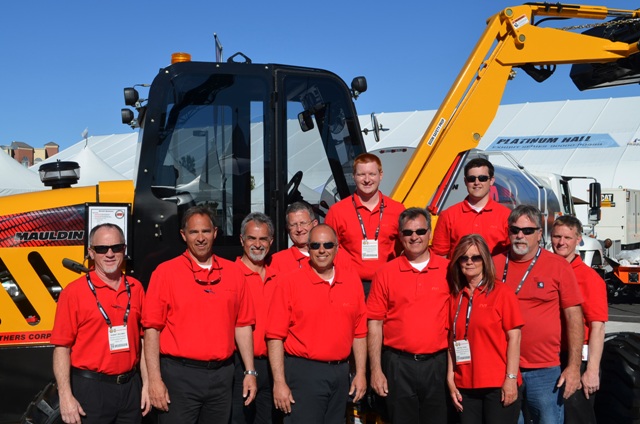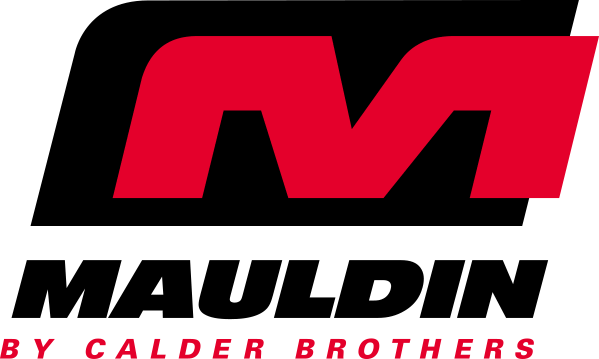It requires a dedicated contingent of highly skilled people to put together a winning combination to transform a marginal company into an award winning global business. Such is the case with Calder Brothers Corporation, manufacturers of Mauldin Paving Products. It must be a total team effort!
Leadership starts at the top of all successful organizations. And, in keeping with the irrefutable Law of Gravity, it flows down to cover those below it. Such is the case with Robert and Marjorie Calder. Married in 1959, they soon had a family of four sons who quickly followed the examples set by their father. As a well-educated international businessman with impeccable credentials, he instilled in his sons the necessity of an advanced education.
Robert Calder took a languishing division of Rockwell International, with yearly sales of approximately $200 million, and improved it to one having in excess of $1.4 billion annually. In all probability, he could not have done this, especially in only 14 years, without both the technical know how and practical, hands-on experience.
Robert first earned a degree in Engineering Physics from Queens University in Kingston, Ontario, Canada. Later he was awarded an MBA from McMasters University in Hamilton, Ontario, also in Canada.
He started his professional career in design engineering with the International Harvester Corporation. Responsibilities with that firm eventually led him to the United States in the product development section of their Construction Equipment Division. From there, it was on to Europe as a corporate vice president with the responsibility for all of Europe, Africa and the Middle East for construction equipment.
Along the way, Robert Calder accumulated a significant amount of design, sales, marketing and management experience. This has enabled him now, as Chairman of the Board of Calder Brothers Corporation, to work directly with one son on product design, engineering and development; discussing strength of materials, stress forces, hydrostatic pressures and proper torque on drive motors. In changing hats, with no loss of time or effort, he can consult with another son on computers, CAD and manufacturing processes. With another, he can consider sales, marketing and management. Changing pace slightly Bob Calder can discuss the firm’s dealer network and dealer strategies with a fourth son.
His sons all followed in his footsteps when it came to formal education. Wayne has degrees in Mechanical Engineering from the University of Illinois. Glen has his Bachelors Degree in Economics from the University of Iowa and an MBA from the University of Central Florida in Orlando. Cameron earned degrees in Marketing from Western Michigan University. David Calder took his Bachelors Degree in Mechanical Engineering from Queens University in Ontario, Canada and his Master’s in Business from Oakland in Rochester, Michigan.
In addition to this, all four sons have gained extensive practical experience in the real world of business, both working for others and owning and operating their own. This has enabled the Calder Brothers to join forces with their father to establish a firm that combines the best of all worlds; a winning combination, if you will.
“After living together in Canada, United States, London and Paris, it was almost a natural occurrence that we would eventually get together as a family business. We went our separate ways during our college period and then went out on our own in the business world. About the only time we got back together for a while was at Christmas, a wedding or other special occasion. When we did, we spent a considerable amount of that time discussing the hours and efforts we spent working for other people and musing on what it could be like if we were all working together in our own business.” —Executive Vice President Glen Calder.
In a family meeting, the criteria were established as to expectations of which industry and products would interest them. They realistically evaluated their expertise, sustainable advantage and the competitive advantages they had to offer.
Once the decision was finalized to join in a family business, and before everyone, with the exception of Wayne Calder, had set down roots too far, the search process began. Wayne already had a wife, three children and owned an engineering business. Time was of the essence. Several of the Calder Brothers gave up their full time jobs to enter into this endeavor.
Letters and inquiries were made to between three and four thousand entities looking for the right business to purchase. This included exploration of many Fortune 500 companies seeking divisions they might be divesting, letters to investment bankers and privately held old-line family businesses. No opportunity that could be found was overlooked.
The end result was, that of the available companies, the Calders narrowed the list down to a short list of four or five companies. Several firms appeared as favorable for acquisition and on site visits led to further evaluations. Management negotiation with the Mauldin Brothers Company led to a purchase agreement in 1994.
The most visible change made to Mauldin after its takeover was in adding and implementing state of the art technology. It was a process of transforming an old line, manually oriented company, into a high technology 21st century assemblage. It was a deliberate forceful proceeding of the entire Calder Brothers Corporation working together, bringing everyone’s’ expertise into the process and changing one item at a time.
First and foremost among this was to establish a repeatable process. It doesn’t matter what the process is. From start to finish, it needs to be repeatable. This applies to order taking, bookkeeping, materials acquisition, manufacturing, marketing and sales. Once it is repeatable it can be controlled and fine tuned” —David Calder.
The drilling and milling in the manufacturing process received immediate attention. A very large vertical machine center to accurately control any and every piece of steel manufactured with two or more holes was the first acquisition. A new computer system was added to the burning table and eliminated the photo eye that previously read the hand drawn patterns. A CNC controlled brake press was added to accurately perform all bending operations.
These changes effectively altered the new Mauldin Paving Products firm from a company relying on hand drawn patterns to a 3D AutoCAD system that networked into the cutting table and provided an exact same repeatable pattern on the burning center. All steel manufacturing processes were now precisely repeatable.
This allowed them to take all the machines up to the next level of quality. And in turn, permitted the introduction of new and significantly more sophisticated designs that required very precise and accurately manufactured parts. This positively augmented Mauldin’s design and manufacturing capabilities and provided them a significant advantage over its competitors.
The next phase was to begin the implementation of quality control systems, which were “people dependent.” This more effectively permitted supervisors to more efficiently control the quality factors that were contingent on the human factor.
New systems were also installed in the parts area, which allowed for the rapid assessment of the status and age of parts orders. Computers were now used to track the time it took from the incoming order until the fill and shipping dates.
The result was to modernize older manual functions to traceable computer programs. In turn, this significantly increased and expedited everything from incoming equipment orders to the shipping of finished machines. Raw materials acquisition, design, engineering and layout, manufacturing, inspection and delivery all increased exponentially.
For the equipment dealer, it resulted in a more saleable product that required less preparation and future field service. That increased profitability. To the end user, the customer, this resulted in improved dependability, reliability and uptime. With increased factory support, including the ability to talk directly to a human voice at the factory, instead of an answering machine that translated into increased dollar value for his or her investment. For the Calder Brothers Corporation, it resulted in increased worldwide marketshares and marked the beginning of the positive fulfillment of a long held family goal.

